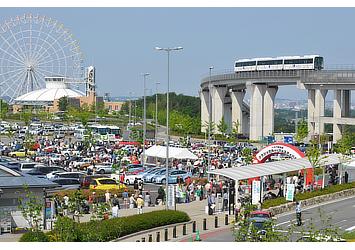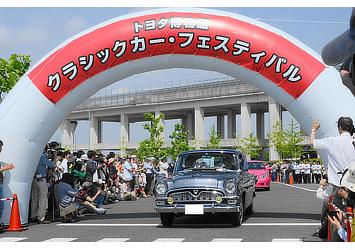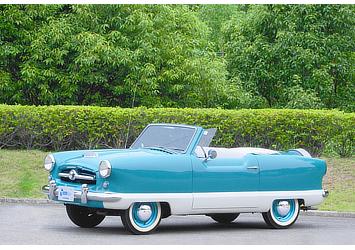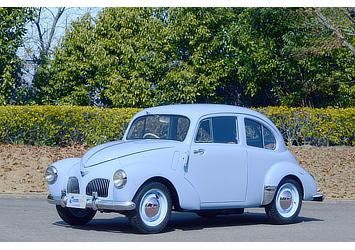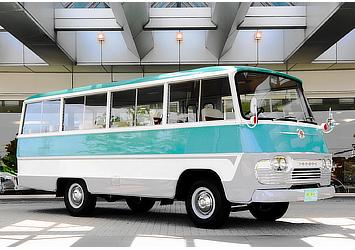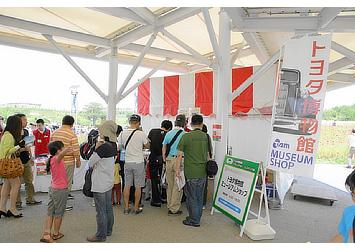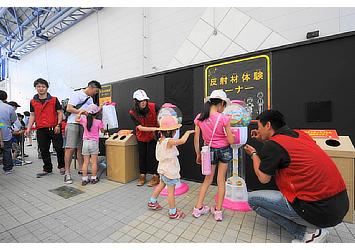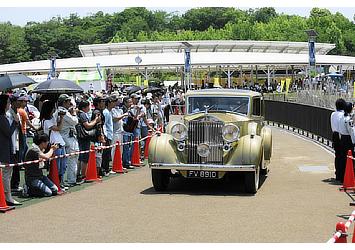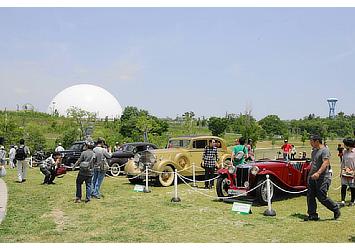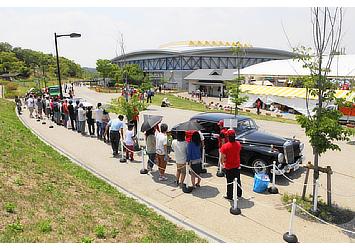Apr. 23, 2014
Toyota to Host 2014 Classic Car Festival in Aichi
Tokyo, Japan, April 23, 2014―Toyota Motor Corporation’s Toyota Automobile Museum will host a classic car festival at the Expo 2005 Aichi Commemorative Park and other locations in Nagakute City, Aichi Prefecture on May 25. The annual festival aims to promote and develop automobile culture and encourage interaction among car fans.
There will be a crosstown parade featuring approximately 100 privately owned classic cars from around the world, and, in line with the museum’s 25th anniversary slogan, “becoming a museum that tells stories”, six of the museum’s vehicles will be exhibited under the theme of “Cutting-edge Vehicles”. One of the vehicles will be the Toyopet “Model SA” passenger car, which significantly influenced cars developed later. Staff curators will give talks on the vehicles and drive them for demonstration.
Other events features include opportunities to take commemorative photos with the Nash “Metropolitan”, the first American compact car produced in Great Britain, and take rides on the Toyota “Light Bus”, which formed the basis for the Toyota “Coaster”.
| Date | May 25, 2014 |
| Time | 9:00-16:00 (regardless of weather, however specific items might be rescheduled) |
| Main location | Oshibafu Hiroba at Aichi World Expo Commemorative Park (Mori-coro Park) |
| Exhibits | Approximately 100 privately owned classic cars, 11 cars from the Toyota Automobile Museum collection, and one car owned by Toyota Auto Body Co., Ltd. |
| Admission | Free |
Details:
| 1) | Classic car parade |
| Vehicles: | The museum’s Toyopet Crown Model RS21 (1960, Japan) will lead the parade, followed by approximately 100 pre-1984 privately owned cars from Japan, the U.S., and Europe. After the parade, the vehicles will be exhibited at Oshibafu Hiroba until 15:30. |
| Course: | Aichi World Expo Commemorative Park (Mori-coro Park)–North Parking Lot, Toyota Automobile Museum, Irigaike Intersection, Hanamizuki Plaza, Nagakute City Office, Nagakute Onsen Gozarasse to Aichi World Expo Commemorative Park (Mori-coro Park)–Oshibafu Hiroba (14 km) |
Note: At 09:00, pamphlets containing raffle tickets will be distributed to the first 300 people at Hanamizuki Plaza and Nagakute Onsen Gozarasse on the parade route. Drawings for Toyota Automobile Goods will be held at these locations.
Interviews with five classic-car owners (12:30-13:00)| 2) | Exhibitions and driving demonstrations of Toyota Automobile Museum cars (see “Appendix” for details) |
Driving Demonstrations and Talks from Curators Session 1 (11:50-12:20)
| - | De Soto Airflow Series SE (1934, U.S.A.) |
| - | Cisitalia 202 Coupe (1947, Italy) |
| - | Tucker '48 (1948, U.S.A.) |
Driving Demonstrations and Talks from Curators Session 2 (13:50-14:20)
| - | Toyopet Model SA (1951, Japan) |
| - | Chevrolet Corvair (1960, U.S.A.) |
| - | Subaru 1000 Super DX (1967, Japan) |
Commemorative photos (09:30-16:00)
| - | Nash Metropolitan (1954, U.S.A.) |
| - | Mercury Cougar XR-7 (1973, U.S.A.) |
Test Rides (12:30-13:00; 13:30-14:00; 14:30-15:00)
| - | Toyota Light Bus (1963, Japan, Toyota Auto Body Co., Ltd. collection) |
| - | Ford Thunderbird (1962, U.S.A.) |
| - | Bentley Continental (1995, U.K.) |
| 3) | Great East Japan Earthquake relief donation booth (09:30-16:00) |
| 4) | Other |
Offers traffic safety events and pedal-powered car rides that can be enjoyed by young families.
Linimo Spring Greenery Walking Tour (start time: 09:30-11:30)
Note: Participants will travel from the Linimo Hanamizuki Dori Station to the Aichi World Expo Commemorative Park (Mori-coro Park) via Nagakute Onsen Gozarasse.The first 2,000 participants to make it to the final destination will receive a commemorative badge.
Market zone
The museum shop as well as many restaurants and eateries from Nagakute City will have booths at the event.
| 5) | Sponsors, Co-sponsors, etc. |
| Sponsors: | Aichi Prefecture, Nagakute City, Aichi Prefectural Board of Education, Nagakute City Board of Education, Nagakute Kankou Suisin Kaigi |
| Co-sponsors: | Aichi Urban Development Association, Aichi Rapid Transit Co., Ltd. Nagakute Onsen Gozarasse / Agurin Mura |
| Supporters: | Toyota City Cultural Promotion Foundation, TOYOTA Illusion Magic, Nagakute Society of Commerce and Industry, Toyota Auto Body Co., Ltd. |
Toyota Automobile Museum website : http://www.toyota.co.jp/Museum/english/
Appendix
| Vehicle (year and country of origin) |
Details |
| Toyopet Crown Model RS21 (1960, Japan) |
The first-generation Crown, launched in 1955, underwent partial redesign in 1959 to give the vehicle a sharper exterior look. The tailfin style popular at the time was adopted for the rear side of the vehicle. The instrument panel was updated and the engine output was increased from 48 to 58 horsepower. In the deluxe version, a grille and side molding with a luxurious feel were adopted. |
Vehicles for Driving Demonstrations (Cutting-edge Vehicles)
| De Soto Airflow Series SE (1934, USA) |
In 1934, this design was one of the first to incorporate a streamlined shape, an innovative vehicle package, and a body structure similar to the modern monocoque, all ground-breaking at the time. However, because these features were perhaps too progressive, the model failed commercially. |
| Cisitalia 202 Coupe (1947, Italy) |
After the second World War, this model became one of the first to incorporate a flash-side design integrating the body with the fenders, and in 1951 was selected by the New York Museum of Modern Art as one of eight superior vehicle models representing modern design. |
| Tuck Tucker '48 (1948, USA) |
This model was created to challenge the Big Three carmakers in post-war U.S. It adopted safety designs that were advanced for the time, including thicker padding surrounding the driver seat and cornering headlights linked to steering direction. |
| Toyopet Model SA (1951, Japan) |
Toyota created this model with much enthusiasm once it was allowed to again develop passenger cars following the second World War. The model employed aerodynamic styling and a backbone frame structure, as well as innovative mechanisms such as 4-wheel independent suspension. |
| Chevrolet Corvair (1960, USA) |
This compact car was created to compete with other compact cars made by Volkswagen and others in the U.S. market. It employed innovative features such as an air-cooled, horizontally opposed engine, rear engine placement, rear wheel drive, and a monocoque structure. |
| Subaru 1000 Super DX (1967, Japan) |
This model adopted cutting-edge technologies such as a horizontally opposed engine and front-wheel drive. In particular, the constant-velocity universal joint used in the front drive shaft greatly contributed to the subsequent development and popularization of front-engine, front-wheel-drive cars. |
Vehicles Available for Commemorative Photos
| Nash Metropolitan (1954, USA) |
This model was produced in Great Britain using components made by Austin Motor Company Limited (Great Britain) and became popular as the first inexpensive, compact city commuter in the U.S. |
| Mercury Cougar XR-7 (1973, USA) |
This model debuted as an upscale version of the Mustang. The vehicle on display is the last model of the second-generation Cougar, which was used to carry the champion of the Nagoya Grand Sumo Tournament in a victory parade around the city. |
Vehicles for Test Rides
| Toyota Light Bus (1963, Japan, Toyota Auto Body collection) |
This model, the predecessor to the current Coaster, debuted in 1963. It played a major role in transporting athletes and spectators at the Tokyo Olympic Games. Its round taillights were adopted in the 2000GT. In 2013, the model was reconstructed for the first time in 50 years by Toyota Auto Body Co., Ltd. to train its young engineers. |
| Ford Thunderbird (1962, USA) |
This third-generation Thunderbird, marketed from 1961 to 1963, is a four-seater convertible, but can be made to look like a two-seater with the installation of a special tonneau cover. The hydraulically operated roof can be raised or lowered with the flip of a switch. |
| Bentley Continental (1995, UK) |
An ultra-luxury personal car that debuted in 1966 as a twin vehicle to the Rolls-Royce. |
| Note: Rain might prevent the display of certain vehicles. |




